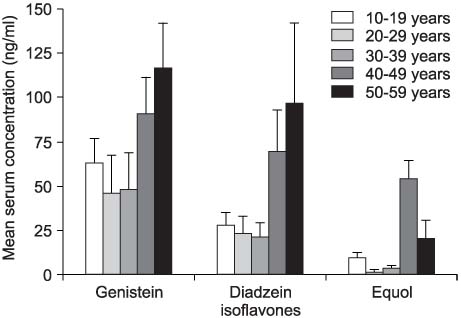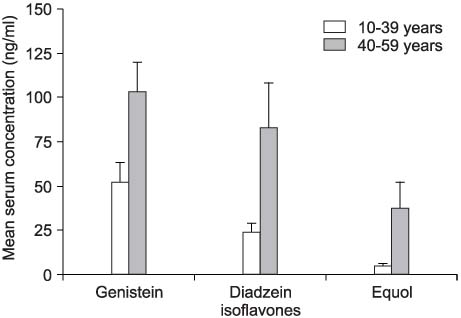Korean J Urol.
2006 Jul;47(7):773-778. 10.4111/kju.2006.47.7.773.
Effects of Dietary Habits on the Serum Isoflavones Levels
- Affiliations
-
- 1Department of Urology, Chungbuk National University College of Medicine, Cheongju, Korea. wjki m@chungbuk.ac.kr
- KMID: 2294321
- DOI: http://doi.org/10.4111/kju.2006.47.7.773
Abstract
-
PURPOSE: Recent studies have suggested that isoflavones have an inverse correlation with the risk of prostate cancer. In addition, the serum isoflavones levels are thought to be decided not only by the level of intake of isoflavones, but also by the metabolic processes or the genetic abilities required for ingestion of isoflavones. So, we conducted this study to determine the effects of dietary habits on the serum isoflavones levels.
MATERIALS AND METHODS
One hundred age- and community-matched healthy men between the ages of 10 and 59 years were interviewed using a food frequency questionnaire that was developed and validated for Korean populations. The individuals' dietary habits during the previous one-year period and the foods they ingested during the previous one-week period before blood sampling were assessed. The serum concentrations of isoflavones were analyzed by the reversed-phase high performance liquid chromatography-multiple reaction ion monitoring-mass spectrometry method (HPLC-MS), (SRL Co. Tokyo, Japan).
RESULTS
The genistein and daidzein levels were significantly correlated with age (p=0.026 and p=0.016, respectively), but the equol level was not (p=0.091). The foods associated with the genistein level were unmilled rice, beans, garlic and etc. The foods significantly related to the daidzein level were unmilled rice, garlic and etc. Of the foods ingested during the previous one-week period, fermented soybean soup, garlic, strawberries and mung-bean pancakes were associated with the equol level.
CONCLUSIONS
The genistein and daidzein levels were associated with usual dietary habits, but the equol level was related to the short-period food consumption. Changes in dietary habit might induce significant changes in the genistein and daidzein levels.
Keyword
MeSH Terms
Figure
Reference
-
1. Cancer statistics, 1998. CA Cancer J Clin. 1998. 48:6–29.2. Cancer statistics, 1998. CA Cancer J Clin. 1999. 49:8–31.3. Robert ER, Jean BD. Walsh PC, Retic AB, Vaughan ED, Wein AJ, editors. Epidemiology, etiology, and prevention of prostate cancer. Campbell's urology. 2002. 8th ed. Philadelphia: Saunders;3003–3004.4. Post PN, Kil PJ, Coebergh JW. Trends in survival of prostate cancer in southeastern Netherlands, 1971-1989. Int J Cancer. 1999. 81:551–554.5. Post PN, Kil PJ, Crommelin MA, Schapers RF, Coebergh JW. Trends in incidence and mortality rates for prostate cancer before and after prostate-specific antigen introduction. A registry-based study in southeastern Netherlands, 1971-1995. Eur J Cancer. 1998. 34:705–709.6. Brasso K, Friis S, Kjaer SK, Jorgensen T, Iversen P. Prostate cancer in Denmark: a 50-year population-based study. Urology. 1998. 51:590–594.7. Brasso K, Iverson P. Prostate cancer in Denmark. Incidence, morbidity and mortality. Scand J Urol Nephrol. 1999. 203:Suppl. 29–33.8. Muir CS, Nectoux J, Staszewski J. The epidemiology of prostate cancer. Geographical distribution and time trends. Acta Oncol. 1991. 30:133–140.9. Shimizu H, Ross RK, Bernstein L, Yatani R, Henderson BE, Mack TM. Cancers of prostate and breast among Japanese and white immigrants in Los Angeles country. Br J Cancer. 1991. 63:963–966.10. Muthyala RS, Ju YH, Sheng S, Williams LD, Doerge DR, Katzenellenbogen BS, et al. Equol, a natural estrogenic metabolite from soy isoflavones: convenient preparation and resolution of R- and S-equols and their differing binding and biological activity through estrogen receptors alpha and beta. Bioorg Med Chem. 2004. 12:1559–1567.11. Kanellakis P, Nestel P, Bobik A. Angioplasty-induced superoxide anions and neointimal hyperplasia in the rabbit carotid artery: suppression by the isoflavone trans-tetrahydrodaidzein. Atherosclerosis. 2004. 176:63–72.12. Chin-Dusting JP, Boak L, Husband A, Nestel PJ. The isoflavone metabolite dehydroequol produces vasodilatation in human resistance arteries via a nitric oxide-dependent mechanism. Atherosclerosis. 2004. 176:45–48.13. Di Virgilio AL, Iwami K, Watjen W, Kahl R, Degen GH. Genotoxicity of the isoflavones genistein, daidzein and equol in V79 cells. Toxicol Lett. 2004. 151:151–162.14. Hussain M, Banerjee M, Sarkar FH, Djuric Z, Pollak MN, Doerge D, et al. Soy isoflavones in the treatment of prostate cancer. Nutr Cancer. 2003. 47:111–117.15. Sergeev IN. Genistein induces Ca2+-mediated, calpain/caspase-12-dependent apoptosis in breast cancer cells. Biochem Biophys Res Commun. 2004. 321:462–467.16. Sasamura H, Takahashi A, Yuan J, Kitamura H, Masumori N, Miyao N, et al. Antiproliferative and antiangiogenic activities of genistein in human renal cell carcinoma. Urology. 2004. 64:389–393.17. Akaza H, Miyanaga N, Takashima N, Naito S, Hirao Y, Tsukamoto T, et al. Is daidzein non-metabolizer a high risk for prostate cancer? A case-controlled study of serum soybean isoflavone concentration. Jpn J Clin Oncol. 2002. 32:296–300.18. Coward L, Kirk M, Albin N, Barnes S. Analysis of plasma isoflavones by reversed-phase HPLC-multiple reaction ion monitoring-mass spectrometry. Clin Chim Acta. 1996. 247:121–142.19. Willet W, Stampfer MJ. Total energy intake: implications for epidemiologic analyses. Am J Epidemiol. 1986. 124:17–27.20. Steinberg GD, Carter BS, Beaty TH, Childs B, Walsh PC. Family history and the risk of prostate cancer. Prostate. 1990. 17:337–347.21. Kim WJ, Lee SC, Jang H, Song JM, Yoon JH, Lee SE, et al. Effects of soybean metabolites on prostate cancer. Korean J Urol. 2003. 44:1093–1097.22. Akaza H, Miyanaga N, Takashima N, Naito S, Hirao Y, Tsukamoto T, et al. Comparisons of percent equol producers between prostate cancer patients and controls: case-controlled studies of isoflavones in Japanese, Korean and American residents. Jpn J Clin Oncol. 2004. 34:86–89.
- Full Text Links
- Actions
-
Cited
- CITED
-
- Close
- Share
- Similar articles
-
- Effects of Isoflavones Supplemented Diet on Lipid Concentrations and Hepatic LDL Receptor mRNA Level in Growing Female Rats
- The Effects of Isoflavones Intake Level on Bone Markers and Bone Related Hormones in Growing Female Rats
- The Effects of Level of Isoflavones Supplementation on Bone Mineral Density in Growing Female Rats
- Validation of soy isoflavone intake and its health effects: a review of the development of exposure biomarkers
- A Study on Dietary Habits, Dietary Behaviors and Body Image Recognition of Nutrition Knowledge after Nutrition Education for Obese Children in Seoul




